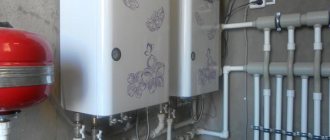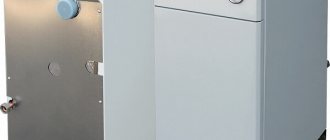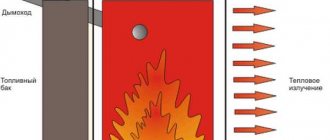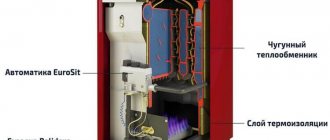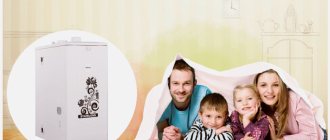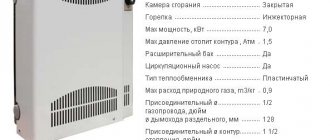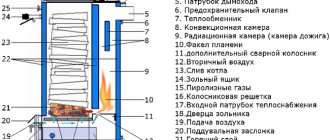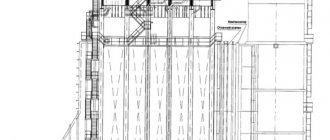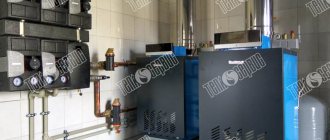Home / Electric boilers
Back
Published: March 24, 2020
Reading time: 5 min
0
874
The ion boiler is used as a heating source in facilities where it is most efficient to use electricity.
Such devices have minimal weight and compact dimensions, making their installation simple and reliable. For installation, it is not necessary to obtain permits from regulatory authorities. In the case when it is necessary to heat a large area, not one ion boiler is installed, but several devices.
This scheme allows you not only to heat the house, but also to heat water for domestic use through an external hot water storage tank.
- 1 History of the appearance of ion boilers
- 2 Advantages and disadvantages
- 3 Design and technical characteristics
- 4 How to choose an ion boiler
- 5 Best manufacturers
- 6 Diagram of the heating system for an ion boiler 6.1 General diagram of connecting an ion boiler
- 6.2 Do such boilers need to be grounded?
Historical excursion
First appearing in the mid-twentieth century, such boilers were used by enterprises of the Soviet defense complex for the needs of the Navy. The compact size of the ion boiler was an ideal model for operation in the limited conditions of the ship. The unit fully coped with its task, worked almost silently, and the role of the coolant in it was performed by sea water.
In the early 90s, the number of orders for the defense industry from the state sharply decreased, and such a successful development for its time as an electric ion heating boiler was not in demand. But engineers A.P. Ilyin used it. and Kunkov D.N., who modified the boiler to an improved “civilian” version and received a patent for their “brainchild” in 1995.
Design features
An ion electrode boiler differs from a conventional boiler in the absence of a heating element, and therefore the heating of the system is carried out entirely due to the characteristics of the special coolant. Instead of a heating element, a block with electrodes is installed in the unit, which serves as the main heating element. Such a replacement made it possible to solve the problems of fragility and low efficiency associated with the operation of most electric boilers.
Despite the seemingly primitive design, the ion heating boiler boasts fairly high efficiency, practicality in use and an almost zero accident rate, which for many private homeowners are decisive factors in favor of choosing such a unit. In addition, if you have the desire and some experience, you can make an ionic electric boiler with your own hands. It is enough to understand the principle of its operation, familiarize yourself with a schematic representation of the design and prepare the necessary materials and tools.
So, externally, such a boiler is a solid steel pipe coated with a layer of polyamide. The following are connected to the product body:
- • coolant inlet/outlet pipes;
- • power supply and grounding terminals;
- • electrode made of a special alloy and insulated with polyamide nuts;
All connector locations are equipped with additional protection against current leakage with rubber gaskets. As you can see, special attention is paid to electrical insulation.
A number of manufacturers equip their ion boilers with automatic control systems. It is the controllers, which include built-in protection against power surges in the network, a starter unit and an electronic thermostat, that allow you to maintain the specified temperature of the coolant, thereby reducing energy consumption. Control can be either direct or remote using GSM channels (in more expensive models).
As for the principle of coolant movement inside the boiler, there are closed and open ion boilers.
Piping an ion boiler in a heating system
As we have already said, an ion boiler is simply a flask with an electrode and pipes for connecting to the circuit. This unit does not contain any equipment that could regulate its operation, so everything necessary must be installed separately. In addition, it is necessary to install the required elements of the heating system, without which the operation of a sealed circuit is impossible. As a result, we need to install:
- security group;
- thermostat;
- circulation pump;
- expansion tank;
- sump;
- fuse block.
Naturally, you cannot do without shut-off valves (ball valves) and American valves so that the boiler can be removed from the circuit for maintenance. All contour elements must be placed correctly. The safety group is installed on the supply, behind the boiler. All other equipment is installed on the return line. A circulation pump is installed in front of the boiler, then a sump tank. Do not let any debris get on the pump impeller to prevent it from breaking.
It is imperative to make good grounding. Don’t joke with this, because we are talking about 220 W, and in three-phase boilers all 380 W can kill.
The expansion tank is installed in front of the pump, where the pressure is stable. Do not forget that the sealed tank must be adjusted, otherwise there will be pressure surges in the system. The thermostat sensor is installed on the return line, where it takes readings of the coolant temperature. You can also use thermostats that control the degree of air heating. This way, you can maintain the same temperature in the room regardless of the weather.
Power from the fuse box is supplied to the boiler electrode through the thermostat. The latter works like a switch. When the water reaches the set temperature, the circuit opens and the boiler stops heating the coolant. When the temperature drops, the thermostat closes the circuit and the boiler starts working.
Maintenance of ion boilers
There is nothing to break in an electrode boiler. Maintenance of ion boilers, according to reviews, comes down to monitoring the amount of salts in the coolant and cleaning the electrode from scale. During operation, scale accumulates on the electrode. It can be removed mechanically, for example, with a grinder with a special brush attachment or coarse sandpaper. It needs to be cleaned until it shines.
In addition, over time, the electrode decreases in size, and the aggressive environment corrodes it. Therefore, sooner or later it will need to be replaced. The main thing is not to miss this moment, since the operation of the boiler and the safety of all equipment directly depends on this.
Principle of operation
The operating principle of the ion boiler is based on a school physics course. The water circulating in the system, which is the coolant, passes between the cathode and the anode and undergoes ionization and sets “+” and “-” charged ions in motion. This process is accompanied by the production of thermal energy.
In one second, the polarity of ions changes up to 50 times. The constant change of polarity prevents the decomposition of the coolant into individual elements - chemical elements - O and H2. The increasing temperature in the boiler, in turn, increases the pressure, which ensures continuous circulation of water through the heating circuit.
It should be taken into account that the use of distilled water in such a boiler is impossible. A system designed for sea water will not be able to provide an electrical circuit between the coolant and the electrodes, and therefore the boiler must be filled with a liquid specially designed for this purpose. Preventing the formation of salt deposits, it will protect pipes from corrosion.
Main characteristics
The main technical characteristics of the ion heating boiler can be found below:
- • The minimum power of the equipment cannot be lower than 2 kW (it is enough to heat rooms up to 80 cubic meters), the maximum reaches 50 kW (suitable for heating large industrial premises up to 1600 cubic meters);
- • The power of units with one phase varies from 2 to 6 kW, with three - from 9 to 50 kW;
- • Energy consumption reaches its nominal level at 75⁰ temperature inside the boiler. At temperatures exceeding the specified one, energy consumption increases and does not correspond to what is stated in the data sheet.
- • The dimensions of a standard domestic boiler are usually no more than 320 mm in diameter, 600 mm in length and 12 kg in weight.
Ion boiler
Many people associate electric heating of a home with the installation of appropriate water boilers with heating elements, convectors, or laying heated film floors. However, there are many more options. In modern private homes, electrode or ion boilers are installed, in which a pair of primitive electrodes transfer energy to the coolant without any intermediaries.
Ion-type heating boilers were first developed and implemented in the Soviet Union to heat submarine compartments. The installations did not cause additional noise, had compact dimensions, there was no need to design exhaust systems, and they effectively heated sea water, which was used as the main coolant.
The heat carrier, which circulates through the pipes and enters the working tank of the boiler, comes into direct contact with the electric current. Ions charged with different signs begin to move chaotically and collide. Thanks to the resistance formed, the coolant heats up.
History of appearance and principle of operation
Within just 1 second, each of the electrodes collides with the others up to 50 times, changing its sign. Thanks to the action of alternating current, the liquid does not divide into oxygen and hydrogen, maintaining its structure. An increase in temperature entails an increase in pressure, which forces the coolant to circulate.
To achieve maximum efficiency of the electrode boiler, you will have to constantly monitor the ohmic resistance of the liquid. At classic room temperature (20-25 degrees), it should not exceed 3 thousand Ohms.
Do not pour distilled water into the heating system. It does not contain any salts in the form of impurities, which means you should not expect it to be heated in this way - there will be no environment between the electrodes to form an electrical circuit.
Read additional instructions on how to make your own electrode boiler here
Characteristics: advantages and disadvantages
An ion-type electrode boiler is characterized not only by all the advantages of electric heating equipment, but also by its own characteristics. The extensive list includes the most significant:
- The efficiency of installations tends to the absolute maximum – not less than 95%
- No pollutants or ion radiation harmful to humans are released into the environment
- High power in a housing that is relatively small in size compared to other boilers
- It is possible to install several units at once to increase productivity, or separate installation of an ion-type boiler as an additional or backup heat source
- Low inertia makes it possible to quickly respond to changes in ambient temperature and fully automate the heating process through programmable automation
- There is no need to install a chimney pipe
- The equipment is not harmed by an insufficient amount of coolant inside the working tank
- Voltage surges do not affect heating performance and stability
You can find out how to choose an electric boiler for heating here
Of course, ion boilers have numerous and very significant advantages. If you do not take into account the negative aspects that arise more often during the operation of the equipment, all benefits are lost.
Among the negative aspects it is worth noting:
- To operate ion heating equipment, you cannot use DC power sources, which will cause electrolysis of the liquid
- It is necessary to constantly monitor the electrical conductivity of the liquid and take measures to regulate it
- It is necessary to ensure reliable grounding. If it breaks down, the risk of being shocked increases significantly
- It is prohibited to use heated water in a single-circuit system for other needs.
- It is very difficult to organize efficient heating with natural circulation; installation of a pump is mandatory
- The temperature of the liquid should not exceed 75 degrees, otherwise the consumption of electrical energy will increase sharply
- Electrodes wear out quickly and need to be replaced every 2-4 years
- Repair and commissioning work cannot be carried out without the involvement of an experienced technician.
Read about other methods of electric heating at home here
Device and technical characteristics
The design of the ion boiler, at first glance, is complex, but it is simple and not forced. Externally, it is a seamless steel pipe, which is covered with a polyamide electrical insulating layer. Manufacturers have tried to protect people as much as possible from electric shock and leaks of expensive energy.
In addition to the tubular body, the electrode boiler contains:
- The working electrode, which is made of special alloys and is held in place by protected polyamide nuts (in models operating from a 3-phase network, three electrodes are provided at once)
- Coolant inlet and outlet pipes
- Ground terminals
- Terminals supplying power to the chassis
- Rubber insulating pads
The shape of the outer body of ion heating boilers is cylindrical. Most common household models meet the following characteristics:
- Length – up to 60 cm
- Diameter – up to 32 cm
- Weight - about 10-12 kg
- Equipment power – from 2 to 50 kW
For domestic needs, compact single-phase models with a power of no more than 6 kW are used. There are enough of them to fully provide heat to a cottage with an area of 80-150 sq. m. For large industrial areas, 3-phase equipment is used. A 50 kW installation is capable of heating a room up to 1600 sq. m.
However, the electrode boiler works most efficiently in conjunction with control automation, which includes the following elements:
- Starter block
- Surge protection
- Controller
Additionally, GSM control modules can be installed for remote activation or deactivation. Low inertia allows you to quickly respond to temperature fluctuations in the environment.
Due attention should be paid to the quality and temperature of the coolant. The optimal liquid in a heating system with an ion boiler is considered to be heated to 75 degrees. In this case, power consumption will correspond to that specified in the documents. Otherwise, two situations are possible:
- Temperature below 75 degrees - electricity consumption decreases along with the efficiency of the installation
- Temperature above 75 degrees - electricity consumption will increase, however, the already high efficiency indicators will remain at the same level
Video guide
Simple DIY ion boiler
Having become familiar with the features and principle by which ion heating boilers operate, it is time to ask the question: how to assemble such equipment with your own hands? First you need to prepare the tools and materials:
- Steel pipe with a diameter of 5-10 cm
- Ground and neutral terminals
- Electrodes
- Wires
- Metal tee and coupling
- Persistence and desire
Before you start putting everything together, there are three very important safety rules to remember:
- Only the phase is supplied to the electrode
- Only the neutral wire is supplied to the housing
- Reliable grounding must be provided
To assemble an ion electrode boiler, just follow the following instructions:
- First, a pipe 25-30 cm long is prepared, which will act as a body
- Surfaces must be smooth and free of corrosion, nicks at the ends must be cleaned
- On the one hand, electrodes are installed using a tee
- A tee is also necessary to organize the outlet and inlet of the coolant
- On the second side they make a connection to the heating main
- Install an insulating gasket between the electrode and the tee (heat-resistant plastic is suitable)
- To achieve a tight seal, the threaded connections must be precisely adjusted to each other.
- To secure the zero terminal and grounding, 1-2 bolts are welded to the body
Having put everything together, you can embed the boiler into the heating system. Such homemade equipment is unlikely to be able to heat a private home, but for small utility areas or a garage it will be an ideal solution. You can cover the installation with a decorative casing, while trying not to restrict free access to it.
Features of installation of ion boilers
A prerequisite for installing ion heating boilers is the presence of a safety valve, pressure gauge and automatic air vent. The equipment must be placed in a vertical position (horizontal or at an angle are not allowed). At the same time, about 1.5 m of supply pipes are not galvanized steel.
The zero terminal is usually located at the bottom of the boiler. A grounding wire with a resistance of up to 4 ohms and a cross-section of over 4 mm is connected to it. You should not rely solely on RAM - it cannot help with current leakage. The resistance must also comply with the rules of the PUE.
If the heating system is completely new, there is no need to prepare the pipes - they must be clean inside. When the boiler crashes into an already operating main, it is necessary to flush it with inhibitors. The markets offer a wide range of products for removing deposits, salts and scale. However, each manufacturer of electrode boilers indicates those that it considers best for its equipment. Their opinion should be followed. By neglecting flushing, it will not be possible to establish the exact ohmic resistance.
It is very important to select heating radiators for the ion boiler. Models with a large internal volume are not suitable, since 1 kW of power will require more than 10 liters of coolant. The boiler will constantly work, wasting some of the electricity in vain. The ideal ratio of boiler power to the total volume of the heating system is 8 liters per 1 kW.
If we talk about materials, it is better to install modern aluminum and bimetallic radiators with minimal inertia. When choosing aluminum models, preference is given to primary type material (not remelted). Compared to the secondary one, it contains fewer impurities, reducing the ohmic resistance.
Cast iron radiators are the least compatible with an ion boiler, since they are the most susceptible to contamination. If it is not possible to replace them, experts recommend observing several important conditions:
- The documents must indicate compliance with the European standard
- Installation of coarse filters and sludge traps is required
- Once again, the total volume of coolant is produced and equipment suitable in terms of power is selected
Manufacturers and average cost
Many heating equipment manufacturers have their own lines of ion-type boilers. Among the most common brands on the market are the following brands:
- "EOU" (Ukraine)
- LLC "Stafor EKO" (Latvia)
- CJSC (Russia)
Small ion boilers (2-3 kW) cost about 3000-3500 thousand rubles . The higher the performance of the equipment, the higher its price. In addition to heating equipment, additional automation is required. It is purchased separately and will cost about 5-6.5 thousand rubles.
Before purchasing, pay due attention to the warranty period. Most manufacturers set it at 2-3 years. By observing operational requirements and regularly (every 3-4 years) replacing the electrodes, the service life can be extended to 10-12 years.
Let's sum it up
Having analyzed all the pros and cons of ion heating equipment, we can draw a conclusion about its profitability. In some aspects it wins, in others it can lose significantly.
However, before choosing heating systems operating on electrical equipment, it is worth considering a number of features:
- If radiators are divided into groups by floor, it is recommended to install an ion boiler on each of them
- It is recommended to wrap the pipes forming the contour with insulation
- You can use antifreeze as a coolant, taking into account its high fluidity
Ion boilers are not suitable for warm baseboard or heated floor systems. They are not capable of reaching a constant operating temperature of 30-45 degrees.
Pros and cons of operation
Reviews based on experience in operating ion boilers are contradictory. And if some consumers are satisfied with the overall dimensions, faster heating of the coolant compared to a traditional electric boiler, resistance to voltage surges and economical use, others only talk about the disadvantages of such equipment. These include:
- • mandatory grounding. The risk of electric shock in the event of an insulator breakdown in such a boiler is significantly higher than in its heating element counterpart;
- • dependence on the quality of the coolant, because the power of the device depends entirely on the degree of conductivity of the water used;
- • inability to operate in emergency mode, for example, from batteries, and use exclusively variable current sources;
- • ban on the use of water from a single-circuit heating system;
- • the impossibility of using such a boiler for installing a heated floor system, etc.
Tips from the professionals
Anyone can install the device, but it is important to do the job well. In this case, a number of rules must be observed. This will avoid problems with the device.
The electrodiode boiler must be installed only in a vertical position
Useful information:
- The electrode boiler is installed only in a vertical position. Operational safety is ensured by separate mounting of the device to the wall, regardless of the rest of the system.
- For grounding, use a copper wire with a diameter of 0.4 mm. Resistance should not exceed 4 ohms.
- The zero terminal is placed at the bottom of the boiler. This makes it easier to attach the ground wire.
- When installing an ion boiler into a previously used heating main, it should be cleaned. To do this, use special products for electrode heating systems.
These techniques were developed by specialists over many years of practice. It is undesirable to repeat mistakes and then redo the system. The owners, taking into account the advice, will not spend additional time optimizing the operation of the device.
Review of popular models
Today, boilers produced by Galan CJSC, EOU, Koterm, STAFOR EKO LLC, etc. are in good demand on the heating equipment market.
The “Ochag” series of the “Galan” brand, represented by the “Ochag2”, “Ochag 3” and “Ochag 5” models, is intended for domestic use and differs in the size and power of the units produced. The “Dachnik” series of ion boilers of the “Coterm” brand is also quite popular. Coterm M1 Summer Resident can be used to heat rooms up to 200 cubic meters. Having 3 power modes (1.2 / 1.7 / 3.5 kW), it has quite economical energy consumption - about 1.5 kW/hour.
It must be said that ion boilers, subject to the operating conditions recommended by the manufacturer, are designed for an impressive service life - up to 10 years. It is recommended to replace electrodes every 2-4 years.
In terms of cost, such units are often much cheaper than other heating boilers, which is an additional advantage in their favor. The price of ion boilers starts from 3000-4000 rubles. for the simplest models. Of course, equipment with advanced functionality will cost much more - from 10,000... 12,000 rubles. and more.
